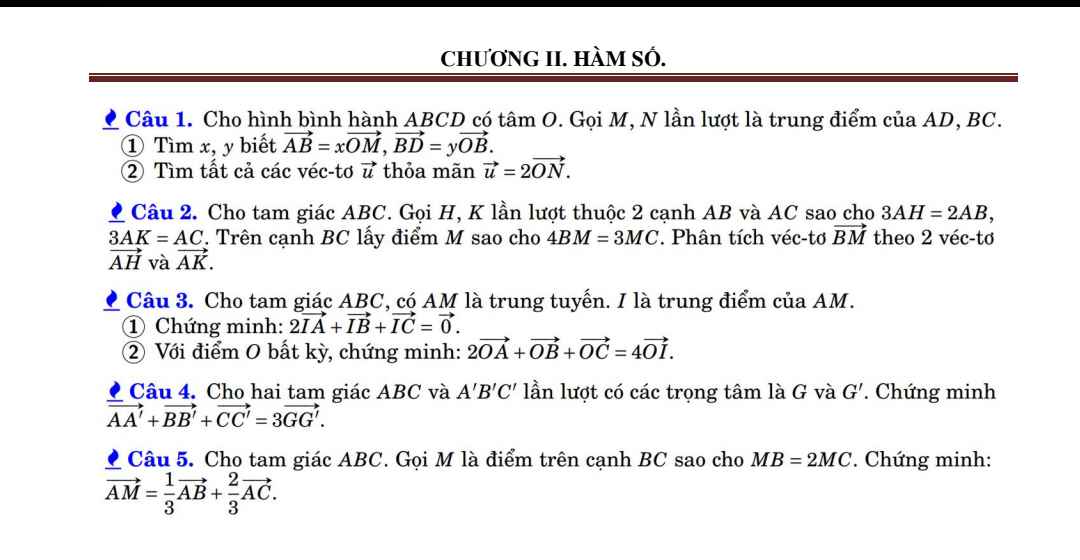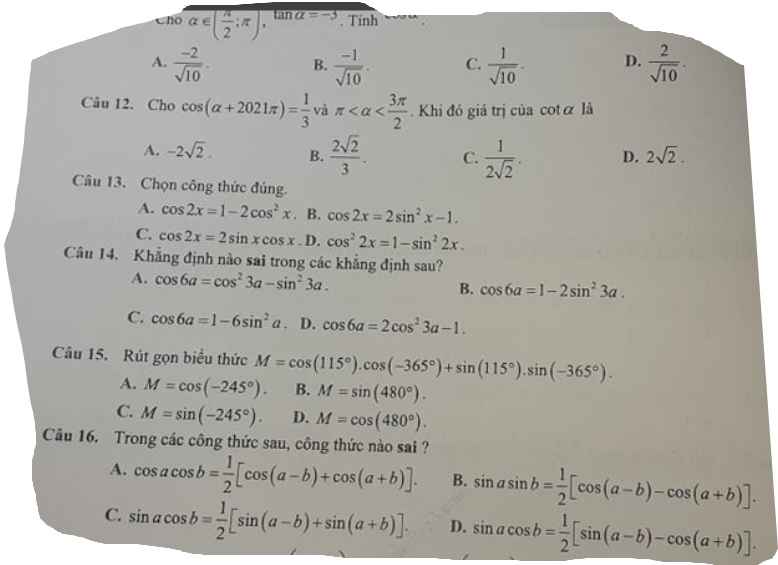
Hãy nhập câu hỏi của bạn vào đây, nếu là tài khoản VIP, bạn sẽ được ưu tiên trả lời.


Câu 1:
1: \(\overrightarrow{OM}=\dfrac{\overrightarrow{OA}+\overrightarrow{OD}}{2}=\dfrac{\overrightarrow{BO}+\overrightarrow{OA}}{2}=\dfrac{\overrightarrow{BA}}{2}=-\dfrac{1}{2}\overrightarrow{AB}\)
\(\Leftrightarrow x=-\dfrac{1}{2}\)
\(\overrightarrow{BD}=2\cdot\overrightarrow{BO}=-2\cdot\overrightarrow{OB}\)
nên y=-2
2: \(2\cdot\overrightarrow{ON}=\overrightarrow{OB}+\overrightarrow{OC}=\overrightarrow{DO}+\overrightarrow{OC}=\overrightarrow{DC}=\overrightarrow{AB}\)
Vậy: Các vecto u thỏa mãn là vecto DC và vecto AB

Lời giải:
GTLN:
Áp dụng BĐT Cauchy-Schwarz:
\(B^2=(6\sqrt{x-1}+8\sqrt{3-x})^2\leq (6^2+8^2)(x-1+3-x)=200\)
\(\Rightarrow B_{\max}= 10\sqrt{2}\Leftrightarrow \frac{3}{\sqrt{x-1}}=\frac{4}{\sqrt{3-x}}\Leftrightarrow x=\frac{43}{25}\)
GTNN:
Ta biết một bổ đề sau: Với \(a,b\geq 0\Rightarrow \sqrt{a}+\sqrt{b}\geq \sqrt{a+b}\)
Cách CM rất đơn giản vì nó tương đương với \(\sqrt{ab}\geq 0\) (luôn đúng)
Áp dụng vào bài toán:
\(\Rightarrow B\geq \sqrt{36x-36+192-64x}=\sqrt{156-28x}\geq 6\sqrt{2}\) (do \(x\leq 3\))
Vậy \(B_{\min}=6\sqrt{2}\Leftrightarrow x=3\)

Thay ![]() = x ;
= x ; ![]() là y nhé bạn =='.
là y nhé bạn =='.
Theo đề bài ta có :
\(\left\{{}\begin{matrix}x+y=23\\x\cdot y=132\\y-x=1\end{matrix}\right.\left(ĐK:x,y>0\right)\)
\(\Leftrightarrow\left\{{}\begin{matrix}x=23-y\\x\cdot y=132\\y-\left(23-y\right)=1\end{matrix}\right.\)
\(\Leftrightarrow\left\{{}\begin{matrix}x=23-y\\x\cdot y=132\\2y=24\Rightarrow y=12\end{matrix}\right.\)
Thay y = 12 vào hai đẳng thức trên ta được :
\(x+12=23\Rightarrow x=11\) hay \(x\cdot12=132\Rightarrow x=11\)
Vậy \(\left\{{}\begin{matrix}x=11\\y=12\end{matrix}\right.\) hay ![]() \(=11\);
\(=11\); ![]() \(=12\).
\(=12\).






Câu 1:
1: \(\overrightarrow{OM}=\dfrac{\overrightarrow{OA}+\overrightarrow{OD}}{2}=\dfrac{\overrightarrow{BO}+\overrightarrow{OA}}{2}=\dfrac{\overrightarrow{BA}}{2}=-\dfrac{1}{2}\overrightarrow{AB}\)
\(\Leftrightarrow x=-\dfrac{1}{2}\)
\(\overrightarrow{BD}=2\cdot\overrightarrow{BO}=-2\cdot\overrightarrow{OB}\)
nên y=-2
2: \(2\cdot\overrightarrow{ON}=\overrightarrow{OB}+\overrightarrow{OC}=\overrightarrow{DO}+\overrightarrow{OC}=\overrightarrow{DC}=\overrightarrow{AB}\)
Vậy: Các vecto u thỏa mãn là vecto DC và vecto AB